Caramaschi, U. & Napoli, M.F.,
2004. The Nomenclatural Status of the Synonyms of Hyla
pardalis Spix, 1824, and the Taxonomic Position of
Hyla biobeba Bokermann and Sazima, 1974
(Anura: Hylidae). Journal of Herpetology, 38(4):500-509.
|
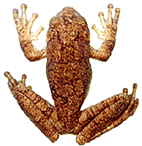
Hyla lundii |
Abstract:
The nomenclatural status of the synonyms of Hyla pardalis
Spix, 1824 is reevaluated, the synonymy of Hyla (Lophopus)
corticalis Burmeister, 1856 is supported, and Hyla
rubropunctata Lutz, 1973 (nomen nudum) is
synonymized to the former. Hyla lundii Burmeister,
1856, previously in the synonymy of H. pardalis, is
revalidated. Hyla pustulosa Reinhardt and Lütken,
1862, and Hyllela punctatissima Reinhardt and Lütken,
1862, previously synonyms of H. pardalis, are
transferred to the synonymy of H. lundii. Hyla
biobeba Bokermann and Sazima, 1974 is synonymized with
H. lundii. Diagnoses and comparisons with the members
of the Hyla boans species group are provided for
H. pardalis and H. lundii, and their geographical
distribution is realized. The type locality of H.
pardalis is discussed and reallocated.
|
Napoli, M.F. &
Caramaschi, U., 2004.
Two new species of the Hyla circumdata group from
Serra do Mar and Serra da Mantiqueira, Southeastern Brazil,
with description of the advertisement call of H.
ibitipoca (Anura, Hylidae). Copeia,
2004(3):534-545.
|
|
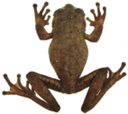
Hyla ahenea sp.nov.
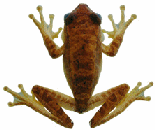
Hyla feioi sp.nov.
|
Abstract:
Two new species of the Hyla
circumdata group are described from southeastern Brazil.
The type localities of both species occur in the Atlantic
Forest Domain. Hyla feioi sp. nov. is described from
Serra do Ibitipoca, a regional designation within the Serra
da Mantiqueira, and Hyla ahenea sp. nov. is described
from Serra da Bocaina, a regional designation within the
Serra do Mar. Descriptions of the tadpole, advertisement
call, and information on natural history are provided for
H. feioi sp. nov. The advertisement call of Hyla
ibitipoca is described.
Resumo:
Duas espécies inéditas do sudeste do Brasil pertencentes ao
grupo de Hyla circumdata são descritas. As
localidades-tipo de ambas as espécies estão localizadas no
Domínio Tropical Atlântico. Hyla feioi sp. nov. é
proveniente da Serra do Ibitipoca, designação regional da
Serra da Mantiqueira, e Hyla ahenea sp. nov. é
proveniente da Serra da Bocaina, designação regional da
Serra do Mar. São fornecidas descrições do girino, canto de
anúncio e informações da história natural de Hyla feioi
sp. nov. É descrito o canto de anúncio de Hyla ibitipoca.
|
Napoli, M.F. & Brandão, F. 2004.
Xenohyla eugenioi
(NCN). Herpetological Review, 35(3):284.
|
| |
Nota completa:
BRAZIL: BAHIA: Ipirá (12o09’S, 39o44’W).
328 m elev.
04 April 1995. Amphibian Collection, Museu de Zoologia,
Universidade Federal da Bahia, Salvador, Bahia, Brazil (UFBA
050). Verified by Ulisses Caramaschi.
This new record
is the northernmost for the species,
and extends its range 161.5 km northward from the
type-locality,
Maracás, Bahia, Brazil (13o25'S, 40o25’W,
964 m altitude) (Caramaschi. 1998. Amphibia-Reptilia
19:377-384). Only two other localities are known for this
species, Poções, Bahia (14o32’S, 40o22’W),
and Planalto Baiano, Bahia (14o40’S, 40o28’W).
|
Napoli, M.F. &
Pimenta, B.V.S., 2003. Nova espécie do grupo de Hyla circumdata (Cope, 1870) do sul da Bahia, Brasil (Amphibia,
Anura, Hylidae). Arquivos do Museu Nacional, Rio de
Janeiro, 61(3):189-194.
|
|
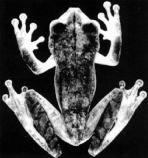
Hyla lucianae
sp.nov.
|
Abstract.
New species of the
Hyla
circumdata group
from southern Bahia, Brazil (Amphibia, Anura, Hylidae).
A new species of the
Hyla circumdata group is described from southern Bahia,
Brazil, inhabiting Atlantic Rain Forests located in the
Municipality of Una, and represents the northernmost
distribution for the species group. The species is
characterized by the medium size, dorsal ground color dark
brown, without well marked transverse dark brown stripes,
and absence of transverse dark brown bars on flanks and
anterior and posterior surfaces of thighs. Natural history
observations and description of advertisement call are
provided.
|
Napoli, M.F. & Brandão, F., 2003.
Eleutherodactylus
paulodutrai
(Paulo's Robber Frog). Herpetological Review,
34(2):2003.
|
|

Eleutherodactylus paulodutrai
|
Nota completa:
BRAZIL: BAHIA:
Municipality
of Salvador, Ondina, Campus da Universidade Federal da Bahia
(12o58’S, 38o30’W; 8m altitude).
24 May 2002. M. F. Napoli. Verified by Ulisses Caramaschi.
Museu Nacional, Rio de Janeiro (MNRJ 30410-30411).
First record outside the type locality (Centro de Pesquisas
do Cacau, Ilhéus, southeastern Bahia, 14o47’S, 39o02’W,
52 m altitude), and northernmost for the species. This new
record extend range ca. 210 km northward. Specimens were
collected at night, while calling in the leaf litter or on
stems and small branches standing upright 60 cm from the
ground.
|
Napoli, M.F., 2002.
Hyla
carvalhoi
(Carvalho's tree frog). Herpetological Review,
33(3):2002.
|
|
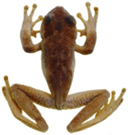
Hyla carvalhoi
|
Nota completa: BRAZIL: RIO DE JANEIRO: Santa Maria Madalena, Parque
Estadual do Desengano (21o53'S, 41o55'W).
1750 m elev. 30 June 1989. R. B. Pineschi. Museu Nacional,
Rio de Janeiro (MNRJ 16983). Verified by Ulisses Caramaschi.
This is the first record outside the type-locality, Parque
Nacional da Serra dos Órgãos, Teresópolis, Rio de Janeiro,
Brazil (22o24'S, 42o57'W), and the
northernmost for the species (aerial distance between the
two localities ca. 110 km), both in Serra dos Órgãos, a
regional designation for the Serra do Mar range.
|
Caramaschi, U.; Napoli, M.F. & Bernardes, A.T.,
2001. Nova espécie do grupo de Hyla circumdata (Cope,
1870) do Estado de Minas Gerais, Brasil (Amphibia, Anura,
Hylidae).
Boletim do
Museu Nacional,
N.S., Zool., Rio de Janeiro, (457):1-11.
|
|
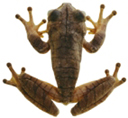
Hyla ravida sp.nov.
|
Abstract:
A new species of the
Hyla circumdata group
from Minas Gerais,
Brazil (Amphibia, Anura, Hylidae).
A new species of the Hyla circumdata group is
described from Vereda Grande Biological Station, a private
reserve in the State of Minas Gerais, Brazil. The new
species is diagnosed by the presence of broad head, large
tympanum, dorsal surfaces grayish brown in life, and small
size. Hyla martinsi, H. langei, and H.
ibitiguara were not considered members of the H.
circumdata species group, mainly by differences in
external morphology, color pattern, and osteological
characters.
|
Napoli,
M.F., 2001.
Xenohyla truncata.
Antipredator
behavior.
Herpetological Review,
32(1): 36-37.
|
|
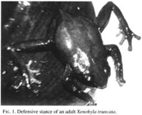
|
Nota
completa:
Xenohyla truncata,
a hylid treefrog from southeastern Brazil, inhabits
terrestrial bromeliads in “restinga” environments (see Eiten
1992. Ann. Acad. Bras. Ci. 64, suppl. 1:35-65) .The first
observation of defensive behavior in
Xenohyla truncata
was reported by Silva et al.
(1987. Resumos XIV Congr. Bras. Zoologia:123).
The authors reported
X. truncata showed tanathosis when specimens fell on
ground, but did not provide data about the posture adopted
by the specimens. An adult X. truncata (Museu
Nacional/Rio de Janeiro 23472) collected from a terrestrial
bromeliad at Barra da Tijuca, city of Rio de Janeiro, State
of Rio de Janeiro, Brazil (ca. 22o54'S, 43o12'W),
was carried to the laboratory to be photographed.
Immediately upon being placed on a table, the specimen
assumed a defensive behavior, stretching their hind limbs
out, inflating the lungs and becoming motionless (Fig. 1). A
similar posture was observed in
Eleutherodactylus
curtipes (Duellman and Trueb 1986. Biology of Amphibia.
McGraw-Hill Book Company, New York. 670 pp.).
Azevedo-Ramos (1995. Rev. Brasil.
Biol. 55:45-47) observed a similar behavior in
Hyla geographica
(= H. semilineata)
from Juréia, State of São Paulo, Brazil, although the
outstretching of hind limbs was not as great and occurred
primarily when the frog was held by its head. This
observation supports the hypothesis of Azevedo-Ramos (op.
cit.) that the outstretched limbs, accompanied by the
inflation of the lungs may prevent or inhabit the ingestion
of the prey. The outstretched hind limbs associated with
immobility in X. truncata may be a
hard-to-ingest-prey posture in a stress situation or a
disruptive posture that breaks the outline of the frog in
the case of visual oriented predators (Azevedo-Ramos, op.
cit.; Sazima 1978. Biotropica 10:158).
|








